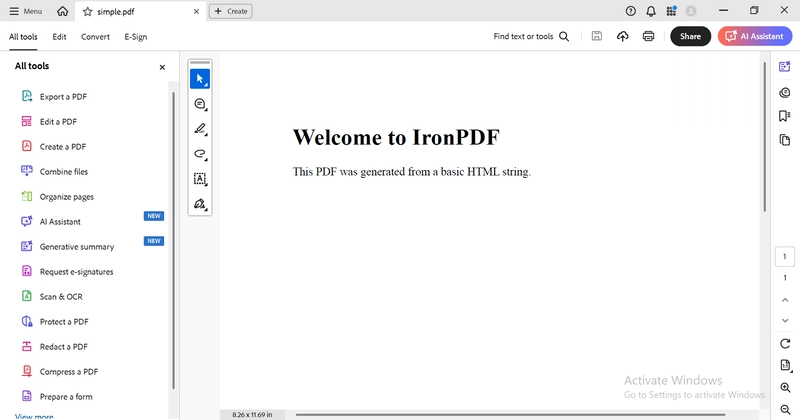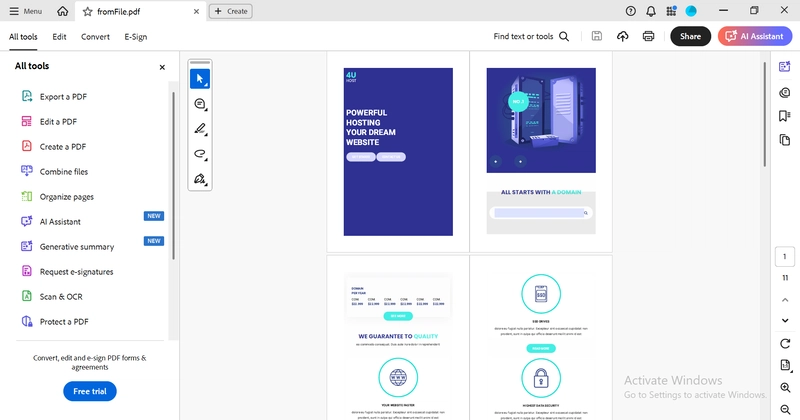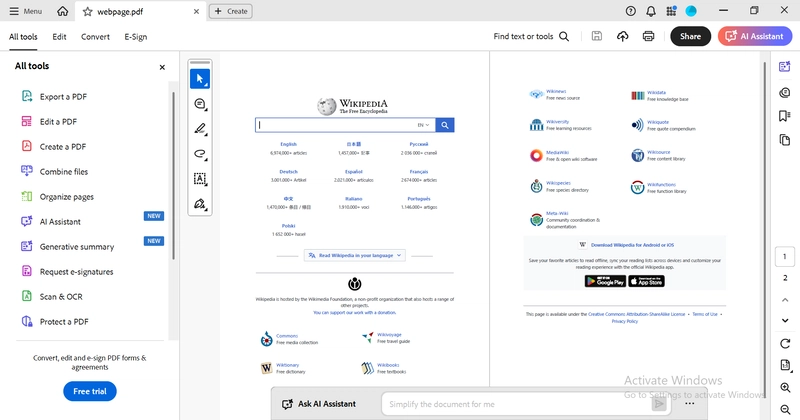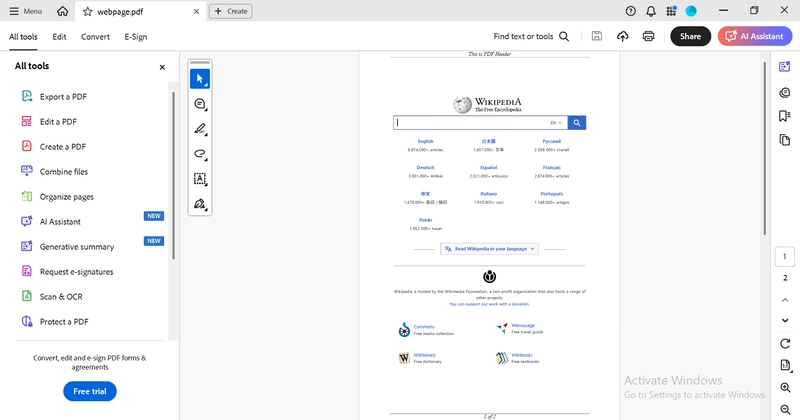How to Convert HTML to PDF in .NET Core
In modern software development, especially in .NET Core applications, converting HTML to PDF is a common requirement. Whether you're generating invoices, exportable reports, or downloadable documents from HTML pages, having a reliable and developer-friendly solution is key. IronPDF is a powerful .NET library that simplifies the task of converting HTML content into fully-rendered, styled, and printable PDF documents. It supports modern HTML5, CSS, and JavaScript, making it capable of handling complex layouts, responsive designs, and embedded resources with ease. In this article, we’ll walk through how to use IronPDF in a .NET Core console application to convert HTML content into PDF documents. Each step is explained with context, and we’ll cover the most common use cases without overwhelming you with edge-case complexities. Getting Started with IronPDF Before we write any code, let’s first install IronPDF and prepare our project. Create a new console project Install the IronPDF NuGet package: Install-Package ironPDF This will add the IronPDF library to your project, allowing you to start working with PDF generation right away. Example # 1: Convert a Simple HTML String to PDF Let’s start with the most basic case—converting a small, static HTML snippet into a PDF file. What we’re going to do: We’ll use IronPDF to render a simple string of HTML that contains a header and a paragraph. Then we’ll save it as a PDF file named simple.pdf. using IronPdf; var renderer = new ChromePdfRenderer(); string htmlContent = "Welcome to IronPDFThis PDF was generated from a basic HTML string."; var pdf = renderer.RenderHtmlAsPdf(htmlContent); pdf.SaveAs("simple.pdf"); What this code does: We create an instance of ChromePdfRenderer, which uses a headless Chrome engine under the hood. A basic HTML string is passed to the RenderHtmlAsPdf() method. The resulting PDF is saved to the disk as simple.pdf. This is the simplest and fastest way to turn HTML into a PDF file using IronPDF. Example # 2: Convert HTML from an External File What we’re going to do: Sometimes, you already have an HTML file designed and ready to go. In this example, we’ll convert an external .html file into a PDF file named fromFile.pdf. using IronPdf; var renderer = new ChromePdfRenderer(); // convert html files var pdf = renderer.RenderHtmlFileAsPdf(@"D:\Tutorial Project\Website\index.html"); pdf.SaveAs("fromFile.pdf"); What this code does: IronPDF reads the HTML file template.html from the file system. It parses and renders the file exactly as a browser would. The PDF output is written to disk as fromFile.pdf. This approach is ideal when working with pre-built templates for invoices, reports, or any standard document layout. Example # 3: Convert a Live Web Page (Public URL) What we’re going to do: If you need to convert a live webpage into a PDF—for example, a receipt page or documentation—we can pass the URL directly to IronPDF. var renderer = new ChromePdfRenderer(); var pdf = renderer.RenderUrlAsPdf(@"https://www.wikipedia.org/"); pdf.SaveAs("webpage.pdf"); What this code does: The RenderUrlAsPdf() method fetches the live HTML from the specified URL. The content is rendered into a PDF, preserving layout, styles, and images. This PDF is saved as webpage.pdf. It’s a quick and practical way to create downloadable versions of existing web pages. Example # 4: Adding Headers and Footers to the PDF What we’re going to do: Now let’s enhance the PDF by adding a header and footer that will appear on every page. This is commonly used for page numbers, titles, or timestamps. using IronPdf; var renderer = new ChromePdfRenderer(); renderer.RenderingOptions.HtmlFooter = new HtmlHeaderFooter() { MaxHeight = 15, HtmlFragment = "{page} of {total-pages}", DrawDividerLine = true }; renderer.RenderingOptions.HtmlHeader = new HtmlHeaderFooter() { MaxHeight = 10, HtmlFragment = "This is PDF Header", DrawDividerLine = true }; renderer.RenderingOptions.MarginTop = 25; renderer.RenderingOptions.MarginBottom = 25; var pdf = renderer.RenderUrlAsPdf(@"https://www.wikipedia.org/"); pdf.SaveAs("webpage.pdf"); What this code does: We set HtmlHeader and HtmlFooter using HtmlHeaderFooter for full HTML customization. The header displays static HTML text; the footer uses placeholders like {page} and {total-pages} for page numbers. Divider lines are added for a clean look, and margins are set to ensure proper spacing. The rest of the webpage is rendered as usual. This feature is great for web captures, reports, and polished, paginated PDFs. Example # 5: Styling the PDF with CSS What we’re going to do: Let’s add a bit of visual design to our PDF using embedded CSS. You can include styling directly in the HTML or reference external stylesheets. using IronPdf;

In modern software development, especially in .NET Core applications, converting HTML to PDF is a common requirement. Whether you're generating invoices, exportable reports, or downloadable documents from HTML pages, having a reliable and developer-friendly solution is key.
IronPDF is a powerful .NET library that simplifies the task of converting HTML content into fully-rendered, styled, and printable PDF documents. It supports modern HTML5, CSS, and JavaScript, making it capable of handling complex layouts, responsive designs, and embedded resources with ease.
In this article, we’ll walk through how to use IronPDF in a .NET Core console application to convert HTML content into PDF documents. Each step is explained with context, and we’ll cover the most common use cases without overwhelming you with edge-case complexities.
Getting Started with IronPDF
Before we write any code, let’s first install IronPDF and prepare our project.
- Create a new console project
- Install the IronPDF NuGet package:
Install-Package ironPDF
This will add the IronPDF library to your project, allowing you to start working with PDF generation right away.
Example # 1: Convert a Simple HTML String to PDF
Let’s start with the most basic case—converting a small, static HTML snippet into a PDF file.
What we’re going to do:
We’ll use IronPDF to render a simple string of HTML that contains a header and a paragraph. Then we’ll save it as a PDF file named simple.pdf.
using IronPdf;
var renderer = new ChromePdfRenderer();
string htmlContent = "Welcome to IronPDF
This PDF was generated from a basic HTML string.";
var pdf = renderer.RenderHtmlAsPdf(htmlContent);
pdf.SaveAs("simple.pdf");
What this code does:
- We create an instance of
ChromePdfRenderer, which uses a headless Chrome engine under the hood. - A basic HTML string is passed to the
RenderHtmlAsPdf()method. - The resulting PDF is saved to the disk as simple.pdf.
This is the simplest and fastest way to turn HTML into a PDF file using IronPDF.
Example # 2: Convert HTML from an External File
What we’re going to do:
Sometimes, you already have an HTML file designed and ready to go. In this example, we’ll convert an external .html file into a PDF file named fromFile.pdf.
using IronPdf;
var renderer = new ChromePdfRenderer();
// convert html files
var pdf = renderer.RenderHtmlFileAsPdf(@"D:\Tutorial Project\Website\index.html");
pdf.SaveAs("fromFile.pdf");
What this code does:
- IronPDF reads the HTML file
template.htmlfrom the file system. - It parses and renders the file exactly as a browser would.
- The PDF output is written to disk as fromFile.pdf.
This approach is ideal when working with pre-built templates for invoices, reports, or any standard document layout.
Example # 3: Convert a Live Web Page (Public URL)
What we’re going to do:
If you need to convert a live webpage into a PDF—for example, a receipt page or documentation—we can pass the URL directly to IronPDF.
var renderer = new ChromePdfRenderer();
var pdf = renderer.RenderUrlAsPdf(@"https://www.wikipedia.org/");
pdf.SaveAs("webpage.pdf");
What this code does:
- The
RenderUrlAsPdf()method fetches the live HTML from the specified URL. - The content is rendered into a PDF, preserving layout, styles, and images.
- This PDF is saved as
webpage.pdf.
It’s a quick and practical way to create downloadable versions of existing web pages.
Example # 4: Adding Headers and Footers to the PDF
What we’re going to do:
Now let’s enhance the PDF by adding a header and footer that will appear on every page. This is commonly used for page numbers, titles, or timestamps.
using IronPdf;
var renderer = new ChromePdfRenderer();
renderer.RenderingOptions.HtmlFooter = new HtmlHeaderFooter()
{
MaxHeight = 15,
HtmlFragment = "{page} of {total-pages} ",
DrawDividerLine = true
};
renderer.RenderingOptions.HtmlHeader = new HtmlHeaderFooter()
{
MaxHeight = 10,
HtmlFragment = "This is PDF Header ",
DrawDividerLine = true
};
renderer.RenderingOptions.MarginTop = 25;
renderer.RenderingOptions.MarginBottom = 25;
var pdf = renderer.RenderUrlAsPdf(@"https://www.wikipedia.org/");
pdf.SaveAs("webpage.pdf");
What this code does:
- We set
HtmlHeaderandHtmlFooterusingHtmlHeaderFooterfor full HTML customization. - The header displays static HTML text; the footer uses placeholders like
{page}and{total-pages}for page numbers. - Divider lines are added for a clean look, and margins are set to ensure proper spacing.
- The rest of the webpage is rendered as usual.
This feature is great for web captures, reports, and polished, paginated PDFs.
Example # 5: Styling the PDF with CSS
What we’re going to do:
Let’s add a bit of visual design to our PDF using embedded CSS. You can include styling directly in the HTML or reference external stylesheets.
using IronPdf;
var renderer = new ChromePdfRenderer();
string html = @"
Styled PDF
This PDF uses CSS for font styles, colors, and spacing.
";
var pdf = renderer.RenderHtmlAsPdf(html);
pdf.SaveAs("styledPdf.pdf");









































































































































































![[The AI Show Episode 144]: ChatGPT’s New Memory, Shopify CEO’s Leaked “AI First” Memo, Google Cloud Next Releases, o3 and o4-mini Coming Soon & Llama 4’s Rocky Launch](https://www.marketingaiinstitute.com/hubfs/ep%20144%20cover.png)



























































































































![[DEALS] The All-in-One Microsoft Office Pro 2019 for Windows: Lifetime License + Windows 11 Pro Bundle (89% off) & Other Deals Up To 98% Off](https://www.javacodegeeks.com/wp-content/uploads/2012/12/jcg-logo.jpg)




























![Is this too much for a modular monolith system? [closed]](https://i.sstatic.net/pYL1nsfg.png)






















































































































_Andreas_Prott_Alamy.jpg?width=1280&auto=webp&quality=80&disable=upscale#)





























































































![What features do you get with Gemini Advanced? [April 2025]](https://i0.wp.com/9to5google.com/wp-content/uploads/sites/4/2024/02/gemini-advanced-cover.jpg?resize=1200%2C628&quality=82&strip=all&ssl=1)













![Apple Shares Official Trailer for 'Long Way Home' Starring Ewan McGregor and Charley Boorman [Video]](https://www.iclarified.com/images/news/97069/97069/97069-640.jpg)
![Apple Watch Series 10 Back On Sale for $299! [Lowest Price Ever]](https://www.iclarified.com/images/news/96657/96657/96657-640.jpg)
![EU Postpones Apple App Store Fines Amid Tariff Negotiations [Report]](https://www.iclarified.com/images/news/97068/97068/97068-640.jpg)
![Apple Slips to Fifth in China's Smartphone Market with 9% Decline [Report]](https://www.iclarified.com/images/news/97065/97065/97065-640.jpg)



































































































































